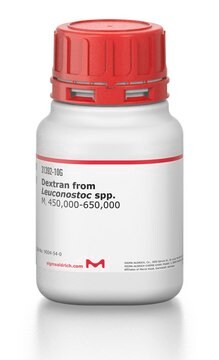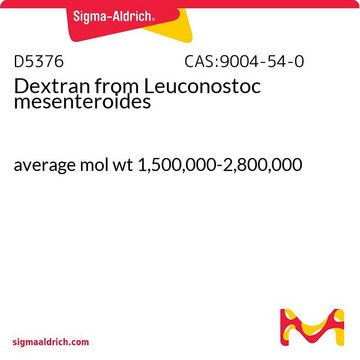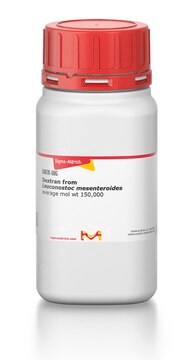31423
Dextran from Leuconostoc mesenteroides
for GPC, Mw 270,000
Sign Into View Organizational & Contract Pricing
All Photos(1)
About This Item
Linear Formula:
(C6H10O5)n
CAS Number:
EC Number:
MDL number:
UNSPSC Code:
12352201
NACRES:
NA.24
Recommended Products
grade
for GPC
Quality Level
mol wt
Mn ~165,000
Mp ~195,000
Mw ~270,000
analyte chemical class(es)
oligosaccharides
technique(s)
gel permeation chromatography (GPC): suitable
Mw/Mn
~1.64
application(s)
food and beverages
format
neat
InChI
1S/C18H32O16/c19-1-5(21)9(23)10(24)6(22)3-31-17-16(30)14(28)12(26)8(34-17)4-32-18-15(29)13(27)11(25)7(2-20)33-18/h1,5-18,20-30H,2-4H2
InChI key
FZWBNHMXJMCXLU-UHFFFAOYSA-N
Looking for similar products? Visit Product Comparison Guide
General description
Dextrans are polysaccharides with molecular weights ≥1,000 Dalton, with a linear backbone of α-linked D-glucopyranosyl repeating units. Dextrans are found as bacterial extracellular polysaccharides. They are synthesized from sucrose by Leuconostoc mesenteroides and Lactobacillus brevis. Bacteria employ dextran in biofilm formation or as a protective coating to evade host phagocytes in the case of pathogenic bacteria.
Dextran from Leuconostoc mesenteroides (Mw: 270,000) may be used as an analytical standard to calibrate the column for gel permeation chromatography (GPC).
Dextran from Leuconostoc mesenteroides (Mw: 270,000) may be used as an analytical standard to calibrate the column for gel permeation chromatography (GPC).
Application
Use of dextrans as long and hydrophilic spacer arms improves the performance of immobilized proteins acting on macromolecules.
Storage Class
11 - Combustible Solids
wgk_germany
WGK 2
ppe
Eyeshields, Gloves, type N95 (US)
Choose from one of the most recent versions:
Already Own This Product?
Find documentation for the products that you have recently purchased in the Document Library.
Customers Also Viewed
Ana Luisa Miranda-Vilela et al.
Journal of biomedical nanotechnology, 9(7), 1261-1271 (2013-08-06)
This work aimed to test a dextran-functionalized magnetic fluid (DexMF) sample in mediating magnetohyperthermia to treat an advanced clinical Ehrlich-solid-tumor, to verify the effects of oral antioxidant administration of pequi-oil on this treatment and to investigate the potential of these
Farwa Sarwat et al.
Pakistan journal of pharmaceutical sciences, 26(4), 793-797 (2013-07-03)
Leuconostoc are known to produce dextran, which have great commercial importance in chemical, medical and food industry. The present study is an attempt to select the best medium for the isolation of indigenous dextran producing Leuconostoc, measuring their enzyme activities
Wai-Leung Langston Suen et al.
Investigative ophthalmology & visual science, 54(6), 4358-4365 (2013-06-01)
This study aims to determine the in vivo effectiveness of low-frequency ultrasound in mediating the transport of macromolecules to the posterior segment of the eye via transscleral route. It investigates if damage is caused by ultrasound at the tested operation
Michael J Pitman et al.
The Annals of otology, rhinology, and laryngology, 122(4), 283-287 (2013-05-24)
We investigated the quantity of recurrent laryngeal nerve motoneurons (RLNMs) that survive after transection and anastomosis of the rat recurrent laryngeal nerve (RLN), as well as the impact of the anastomosis site on RLN regeneration. Ten rats underwent right RLN
Lamiaa M A Ali et al.
Journal of biomedical nanotechnology, 9(7), 1272-1285 (2013-08-06)
Superparamagnetic iron oxide nanoparticles (SPIONs) are inorganic nanomaterials gaining strong clinical interest due to their increasing number of biological and medical applications. The stabilization of SPIONs in a biocompatible stable suspension (bioferrofluid) is generally achieved by an adequate polymeric coating.
Our team of scientists has experience in all areas of research including Life Science, Material Science, Chemical Synthesis, Chromatography, Analytical and many others.
Contact Technical Service









